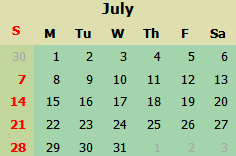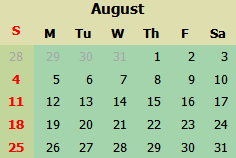Team:SCU China/Notebook
From 2013.igem.org
Zhangbingbio (Talk | contribs) |
Zhangbingbio (Talk | contribs) |
||
| (46 intermediate revisions not shown) | |||
| Line 1: | Line 1: | ||
{{SCU-head}} | {{SCU-head}} | ||
| - | + | <html> | |
| - | + | <body> | |
| + | <div id="SCU"> | ||
| + | <ul style="font-family:Verdana;;"> | ||
| + | <!-- CSS Tabs --> | ||
| + | <li><a href="https://2013.igem.org/Team:SCU_China"><span style="width:90px; text-align: center;font-size: small;">Home</span></a></li> | ||
| + | <li><a href="https://2013.igem.org/Team:SCU_China/Team"><span style="width:90px;text-align: center;font-size: small;">Team</span></a></li> | ||
| + | <li><a href="https://2013.igem.org/Team:SCU_China/Project"><span style="width:90px;text-align: center;font-size: small;">Project</span></a></li> | ||
| + | <li><a href="https://2013.igem.org/Team:SCU_China/Modeling"><span style="width:100px;text-align: center;font-size: small;">Modeling</span></a></li> | ||
| + | <li><a href="https://2013.igem.org/Team:SCU_China/Parts"><span style="width:100px;text-align: center;font-size: small;">Parts</span></a></li> | ||
| + | <li><a href="https://2013.igem.org/Team:SCU_China/Safety"><span style="width:100px;text-align: center;font-size: small;">Safety</span></a></li> | ||
| + | <li><a class=this href="https://2013.igem.org/Team:SCU_China/Notebook"><span style="width:100px;text-align: center;font-size: small;">Notebook</span></a></li> | ||
| + | <li><a href="https://2013.igem.org/Team:SCU_China/Attributions"><span style="width:100px;text-align: center;font-size: small;">Attributions</span></a></li> | ||
| + | <li><a href="https://2013.igem.org/Main_Page"><span style="width:100px;text-align: center;font-size: small;">iGEM 2013</span></a></li> | ||
| + | |||
| + | |||
| + | |||
| + | </ul> | ||
| + | </div> | ||
| + | |||
| + | </body></html> | ||
| + | |||
| + | |||
| + | {|style="width:200px;background-color:transparent" border="0" cellspacing="0" align=center | ||
| + | |||
| + | |[[file:SCU-Mar1.png|160x200px|link=https://2013.igem.org/SCU_Weekly#Weekly_Notes]] | ||
| + | |||
| + | |[[file:SCU-Jun.png|160x200px|link=https://2013.igem.org/SCU_Weekly#June]] | ||
| + | |||
| + | |[[file:SCU-July.png|160x200px|link=https://2013.igem.org/SCU_Weekly#July]] | ||
| + | |||
| + | |[[file:SCU-Aug.png|160x200px|link=https://2013.igem.org/SCU_Weekly#August]] | ||
| + | |||
| + | |[[file:SCU-Sep1.png|160x200px|link=https://2013.igem.org/SCU_Weekly#September]] | ||
| + | |} | ||
| + | __NOEDITSECTION__ | ||
| + | {|style="width: 806px" border="0" cellspacing="1" cellpadding="15px" align="center" | ||
| | | | ||
| + | ---- | ||
| + | =='''iGEM SCU experiment protocol'''== | ||
| + | __TOC__ | ||
| + | ==='''Transformation'''=== | ||
| + | |||
| + | #Thaw the competent cells on ice for about 10-15 minutes. | ||
| + | #Add 50 μL of thawed competent cells into each pre-chilled 1.5mL eppendorf tube. | ||
| + | #Add 1.5 μL of the resuspended DNA (or 4 μL of the ligation product) to the 1.5 mL tube, gently pipet up and down for a few times, make sure to keep the competent cells on ice. | ||
| + | #Close the tubes and incubate the cells on ice for 30 minutes. | ||
| + | #Heat shock the cells by immersion in a pre-heated water bath at 42 ℃ for 60-90 seconds. | ||
| + | #Incubate the cells on ice for 5 minutes. | ||
| + | #Add 300 μL of SOC (make sure that the broth does not contain antibiotics and is not contaminated) to each tube. | ||
| + | #Incubate the cells at 37 ℃ for 1-2 hours while the tubes are rotating or shaking (The purpose of this step is to ensure the transformation efficiency). | ||
| + | #Distribute 200 μL transformed cells uniformly over the appropriate LB plate (containing the proper antibiotics or not). | ||
| + | #Incubate the plates at 37 ℃ for 12-14 hours, make sure the agar side of the plate is up. | ||
| + | |||
| + | | ||
| + | |||
| + | ==='''Liquid culture to grow bacteria from a single colony'''=== | ||
| + | |||
| + | #Add 5 mL LB into each 10 mL or 15 mL tube. | ||
| + | #Add proper antibiotics solution into each tube; | ||
| + | #Pick a single colony on plates with tweezers clamping a pipette tip and then drop the tip containing transformed cells into appropriate LB containing proper antibiotics. | ||
| + | #Seal tubes with sterile sealing film. | ||
| + | #Incubate the cells at 37 ℃ for overnight while the tubes are rotating or shaking. | ||
| + | |||
| + | | ||
| + | |||
| + | ==='''3A Assembly'''=== | ||
| + | |||
| + | #Restriction Digests | ||
| + | |||
| + | #The left part sample is cut out with ''Eco''R I and ''Spe'' I. | ||
| + | #The right part sample is cut out with ''Xba ''I and ''Pst ''I. | ||
| + | #The linearized plasmid backbone, which is harvested by PCR,is a linear piece of DNA. It has a few bases beyond the ''Eco''R I and ''Pst ''I restriction sites. It is cut with ''Eco''R I and ''Pst'' I. | ||
| + | |||
| + | #All 3 restriction digests are heated at 80 ℃ for 20 minutes in PCR meter to heat kill all of the restriction enzymes. | ||
| + | #An equimolar quantity (relative quantity) of all 3 restriction digest products are combined in a ligation reaction. | ||
| + | #The desired result is the left part sample's ''Spe ''I overhang ligated with the right part sample's ''Xba ''I overhang resulting in a scar that cannot be cut with any of our enzymes. | ||
| + | #The new composite part sample is ligated into the construction plasmid backbone at the ''EcoR ''I and ''Pst ''I sites. | ||
| + | #When the ligation is transformed into cells and grown on plates with antibiotic C, only colonies with the correct construction are survived. | ||
| + | |||
| + | | ||
| + | |||
| + | ==='''Traditional assembly (standard assembly) methods'''=== | ||
| + | |||
| + | For Standard Assembly, a part sample is cut out from its plasmid backbone and inserted into the prefix of a plasmid backbone of another part (we use ''Eco''RⅠand ''Xba Ӏ ''to digest plasmid backbone and use ''Eco''RⅠand ''Spe''Ⅰto digest the target part). Two restriction digests are done, one for the part sample that will be moved and one for the plasmid backbone that will receive it. The digests are then run on a gel and using gel purification the required fragments are isolated (the part sample and the cut plasmid backbone). The purified insert and cut plasmid backbone are ligated and the resulting composite part can be transformed into ''E. coli ''cells. | ||
| + | |||
| + | | ||
| + | |||
| + | ==='''Miniprep protocol'''=== | ||
| + | |||
| + | We use MINIPREP PLASMID KIT (TIANGEN BIOTECH, CHINA) for miniprep. | ||
| + | |||
| + | | ||
| + | |||
| + | ==='''Restriction digestion'''=== | ||
| + | |||
| + | We conduct our experiments following the standard protocol from the HD, except for no adding BSA into our mixture. | ||
| + | |||
| + | | ||
| + | |||
| + | ==='''Ligation'''=== | ||
| + | |||
| + | We follow the standard protocol from HD web to conduct our ligation experiments. | ||
| + | |||
| + | | ||
| + | |||
| + | ==='''Making linearized plasmid backbones'''=== | ||
| + | |||
| + | We do this by the bulk production protocol from HD. | ||
| + | |||
| + | | ||
| + | |||
| + | ==='''Competent cells'''=== | ||
| + | |||
| + | We choose DH5α from TIANGEN BIOTECH as our competent cells meterials. | ||
| + | |||
| + | | ||
| + | ==='''Quantifying fluorescence of GFP expressed in ''E. coli'''''=== | ||
| + | We choose plate reader to detect fluorescence of GFP expressed in ''E. coli.'' | ||
| + | Before detecting the fluorescence on plate reader, we view the fluorescence of ''E. coli'' with a fluorescence microscope to make sure that GPF expresses normally ''in vivo.'' | ||
| + | Incubate bacteria for certain periods of time, then take some sample out and add it into each well on 96 well plate (for our experiment, we add 150 μL per well). | ||
| + | | ||
|} | |} | ||
| + | | ||
Latest revision as of 21:26, 27 September 2013


| 
| 
| 
| 
|
iGEM SCU experiment protocolTransformation
Liquid culture to grow bacteria from a single colony
3A Assembly
Traditional assembly (standard assembly) methodsFor Standard Assembly, a part sample is cut out from its plasmid backbone and inserted into the prefix of a plasmid backbone of another part (we use EcoRⅠand Xba Ӏ to digest plasmid backbone and use EcoRⅠand SpeⅠto digest the target part). Two restriction digests are done, one for the part sample that will be moved and one for the plasmid backbone that will receive it. The digests are then run on a gel and using gel purification the required fragments are isolated (the part sample and the cut plasmid backbone). The purified insert and cut plasmid backbone are ligated and the resulting composite part can be transformed into E. coli cells.
Miniprep protocolWe use MINIPREP PLASMID KIT (TIANGEN BIOTECH, CHINA) for miniprep.
Restriction digestionWe conduct our experiments following the standard protocol from the HD, except for no adding BSA into our mixture.
LigationWe follow the standard protocol from HD web to conduct our ligation experiments.
Making linearized plasmid backbonesWe do this by the bulk production protocol from HD.
Competent cellsWe choose DH5α from TIANGEN BIOTECH as our competent cells meterials.
Quantifying fluorescence of GFP expressed in E. coliWe choose plate reader to detect fluorescence of GFP expressed in E. coli. Before detecting the fluorescence on plate reader, we view the fluorescence of E. coli with a fluorescence microscope to make sure that GPF expresses normally in vivo. Incubate bacteria for certain periods of time, then take some sample out and add it into each well on 96 well plate (for our experiment, we add 150 μL per well).
|
 "
"